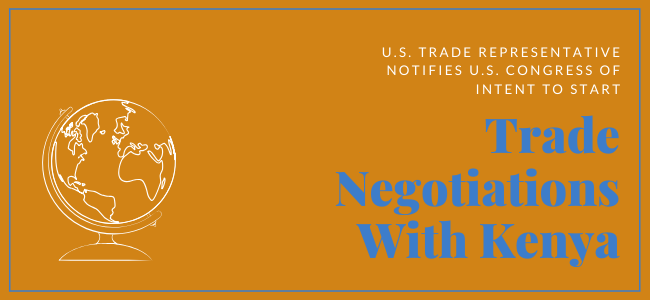The U.S. Trade Representative formally took the first steps to negotiate a trade agreement with Kenya last week – an effort that will dovetail with the U.S. Grains Council’s (USGC’s) expanding work to promote U.S. coarse grains and co-products to a growing market in need of animal feed.
“Our vision is to conclude an agreement with Kenya that can serve as a model for additional agreements in Africa, leading to a network of agreements that contribute to Africa’s regional integration objectives,” wrote U.S. Trade Representative Robert Lighthizer in the official notification to the U.S. Congress on March 17. “The economic relationship of the United States and Kenya is growing and presents significant opportunities for U.S. trade and investment to the benefit of Americans and Kenyans alike.”
Kenya is a large and influential market in the East African region with a population predicted to double and per capita income expected to increase by 150 percent by 2050. With this increase in population and economic growth, domestic food demand is predicted to triple within the same timeframe.
In the short term, however, Kenya’s feed industry is facing severe supply shortages. Kenya does produce nearly 730,000 metric tons (28.7 million bushels) of feed annually – enough to meet between 60 and 70 percent of feed grain demand. However, drought conditions and post-harvest losses in recent years have resulted in a nearly 330,000-ton (nearly 13 million bushels) feed shortage.
Adding to this production issue, the country is experiencing the worst infestation of desert locust swarms in 70 years. To date, locusts have infested 26 of Kenya’s 46 counties. Should laid eggs hatch, a second wave of locust outbreak could further destroy and damage crops in the country.
These detrimental factors heighten demand for feed grains, increase prices for locally-produced corn and cause frequent price fluctuations. Additionally, since corn is also a staple for human consumption in the region, it is often diverted from animal feed when supplies are tight.
The feed industry is putting pressure on the Kenyan government to improve feed supplies by allowing procurement of lower-cost feedstocks. Therefore, the government is considering U.S. origin. The Council is providing support for this effort by extending existing programs in Tanzania to Kenya.
“Supply shortages and increasing feed prices will continue to be exacerbated as a booming population creates even more need for grain for human and animal consumption,” said Kurt Shultz, USGC senior director of global strategies, who oversees USGC operations in Africa. “U.S. coarse grains and co-products are a viable solution to the high cost of locally produced feed ingredients.”
In 2019, the Council signed a memorandum of understanding (MOU) with the Association of Kenya Feed Manufacturers (AKEFEMA), pledging to work together to develop the domestic feed industry through association capacity building, industry development, alternative feed promotion and advocacy work with the Kenyan government.
The Council also sent its first commercial mission to East Africa in 2019 to discuss the potential for alternative feedstocks like U.S. sorghum and dried distiller’s grains with solubles (DDGS), supported by funding from the U.S. Department of Agriculture’s (USDA’s) Agricultural Trade Promotion (ATP) program. The Council is also using the Quality Samples Program (QSP) to ship containers of U.S. DDGS and sorghum to the region for trials – putting U.S. feed ingredients to the test.
A trade agreement between the United States and Kenya – the first of its kind with a sub-Saharan Africa – could further these efforts. Kenya instituted a ban on genetically modified food and feed products in 2012 and has cost-prohibitive tariffs in place that limit the export potential of corn, sorghum and ethanol (except for ethanol for cooking).
“In the trade negotiation process, the Council seeks to eliminate or phase out tariffs impacting coarse grains and co-products, including ethanol for fuel,” said Floyd Gaibler, USGC director of trade policy. “As an organization, we also work to support chapters on sanitary and phytosanitary issues and biotech restrictions through language similar to that in the United States-Mexico-Canada Agreement (USMCA).”
The Council will continue to provide input during the ramp-up to an official start to negotiations – no earlier than 90 days from USTR’s notification to the U.S. Congress. As this process continues, the Council is continuing to work with the Quality Samples Program and developing technical workshops with AKEFEMA on improving feed formulations and management.
“Part of the Council’s mission is to determine how to enable trade when markets do not currently work,” Shultz said. “Combined with sound trade policy, the Council’s market development work in Kenya is striving to build another long-term market for U.S. coarse grains, co-products and ethanol.”
About The U.S. Grains Council
The U.S. Grains Council develops export markets for U.S. barley, corn, sorghum and related products including distiller’s dried grains with solubles (DDGS) and ethanol. With full-time presence in 28 locations, the Council operates programs in more than 50 countries and the European Union. The Council believes exports are vital to global economic development and to U.S. agriculture’s profitability. Detailed information about the Council and its programs is online at www.grains.org.

